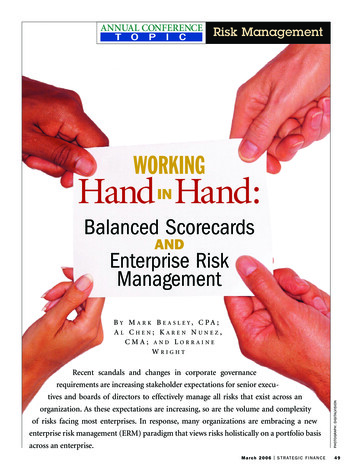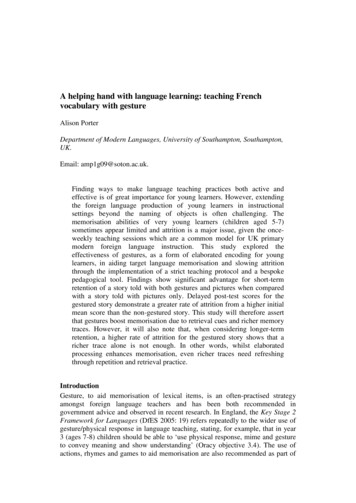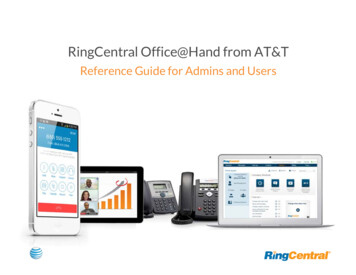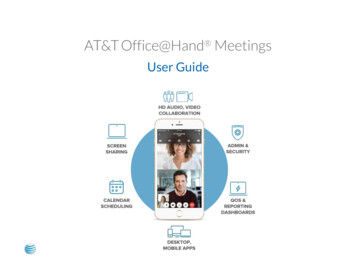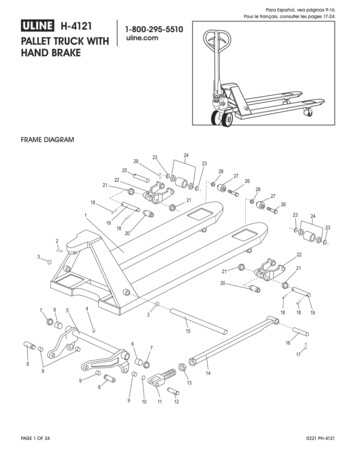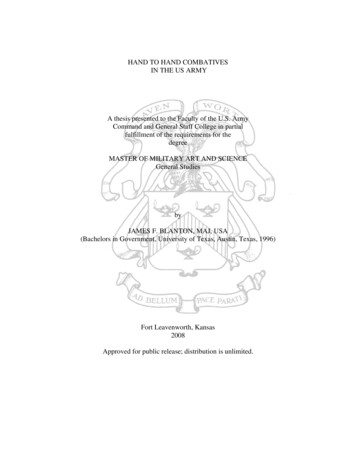
Transcription
HAND TO HAND COMBATIVESIN THE US ARMYA thesis presented to the Faculty of the U.S. ArmyCommand and General Staff College in partialfulfillment of the requirements for thedegreeMASTER OF MILITARY ART AND SCIENCEGeneral StudiesbyJAMES F. BLANTON, MAJ, USA(Bachelors in Government, University of Texas, Austin, Texas, 1996)Fort Leavenworth, Kansas2008Approved for public release; distribution is unlimited.
REPORT DOCUMENTATION PAGEForm ApprovedOMB No. 0704-0188Public reporting burden for this collection of information is estimated to average 1 hour per response, including the time for reviewing instructions, searching existing datasources, gathering and maintaining the data needed, and completing and reviewing this collection of information. Send comments regarding this burden estimate or anyother aspect of this collection of information, including suggestions for reducing this burden to Department of Defense, Washington Headquarters Services, Directorate forInformation Operations and Reports (0704-0188), 1215 Jefferson Davis Highway, Suite 1204, Arlington, VA 22202-4302. Respondents should be aware thatnotwithstanding any other provision of law, no person shall be subject to any penalty for failing to comply with a collection of information if it does not display a currently validOMB control number. PLEASE DO NOT RETURN YOUR FORM TO THE ABOVE ADDRESS.1. REPORT DATE (DD-MM-YYYY)2. REPORT TYPE3. DATES COVERED (From - To)12-12-2008Master’s ThesisFEB 2008 – DEC 20084. TITLE AND SUBTITLE5a. CONTRACT NUMBERHand to Hand Combatives in the US Army5b. GRANT NUMBER5c. PROGRAM ELEMENT NUMBER6. AUTHOR(S)5d. PROJECT NUMBERMAJ James F. Blanton5e. TASK NUMBER5f. WORK UNIT NUMBER7. PERFORMING ORGANIZATION NAME(S) AND ADDRESS(ES)8. PERFORMING ORG REPORTNUMBERU.S. Army Command and General Staff CollegeATTN: ATZL-SWD-GDFort Leavenworth, KS 66027-23019. SPONSORING / MONITORING AGENCY NAME(S) AND ADDRESS(ES)10. SPONSOR/MONITOR’SACRONYM(S)11. SPONSOR/MONITOR’S REPORTNUMBER(S)12. DISTRIBUTION / AVAILABILITY STATEMENTApproved for Public Release; Distribution is Unlimited13. SUPPLEMENTARY NOTES14. ABSTRACTAn analitical review of the present state of modern army combatives, how it compares to thecombative systems of other US military services and foreign militaries. The guidance fortraining combatives, what training is coducted and the application of the training in combat.Finally any recommendations for improvements to the modern army combatives programs.15. SUBJECT TERMSHand to Hand Combatives, Modern Army Combatives Program, Marine Corp Martial ArtsProgram, Air Force Combatives Program, Sambo, Krav Maga, Tae Kwon Do, Tukong Moosul16. SECURITY CLASSIFICATION OF:a. REPORTb. ABSTRACTc. THIS PAGE(U)(U)(U)17. LIMITATIONOF ABSTRACT18. NUMBEROF PAGES(U)10619a. NAME OF RESPONSIBLE PERSON19b. PHONE NUMBER (include area code)Standard Form 298 (Rev. 8-98)Prescribed by ANSI Std. Z39.18ii
MASTER OF MILITARY ART AND SCIENCETHESIS APPROVAL PAGEName of Candidate: MAJ James F. BlantonThesis Title: HAND-TO-HAND COMBAT IN THE US ARMYApproved by:, Thesis Committee ChairMr. Michael Langley, MA, MemberLTC Martin F. Adams, MA,MemberCOL Kendra Kattelmann, Ph.D.Accepted this12th day of December 2008 by:, Director, Graduate Degree ProgramsRobert F. Baumann, Ph.D.The opinions and conclusions expressed herein are those of the student author and do notnecessarily represent the views of the U.S. Army Command and General Staff College orany other governmental agency. (References to this study should include the foregoingstatement.)iii
ABSTRACTHAND-TO-HAND COMBATIVES IN THE U.S. ARMY by MAJ James F. BlantonThe Modern Army Combatives Program was adopted by the U.S. Army in 2000.The program is the culmination of a directive by the Commander of 2nd Battalion, 75thRanger Regiment in 1995 to improve the Army’s older and unused combatives program.Modern Army Combatives is a ground based fighting system that teaches soldiers toclose the gap between him or herself, gain dominance and finishes the fight. Theprogram’s roots are in Brazilian Jujitsu, but is this the right program for the averagesoldier on today’s battlefield? The attempt to answer this question was conducted by firstanalyzing the Army’s program, then examining the Marine Corps, the Air Forces, theRussian military, the Israeli military, and the Korean military programs. Each forcesprogram was then compared to Modern Army Combatives. In order to support the thesisof this paper, surveys and interviews from various organizations within the Army wereconducted and in-depth interviews with martial arts experts from outside the militarywere used to provide a greater depth to the research. The current program has set thestage very well for the Army’s hand-to-hand training, but through the half a dozenchanges recommend in the thesis it can only get better.iv
ACKNOWLEDGMENTSI would like to acknowledge and thank the following individuals or groups, withoutwhose assistance I would not have been able to write this thesis.Mr. Michael L. LangleyCOL Kendra KattelmannLTC Martin F. AdamsMr. George F. ChandlerGrandmaster Young Hak Lee, Tae Kwon Do, Lacey, WAMaster Jason Lee, Tae Kwon Do, Lacey, WAMr. Kelly McCannMr. Scott Anderson, SamboLtCol Kevin Adelsen, USAFMr. Matt Larson, US Army Combatives School, Ft. Benning, GAMSGT Coleman, USMCGySgt Friend, USMCSGT Flynn, US Army Combatives School, Ft. Benning, GAMr. Steve Woolridge, Krav MagaSoldiers, NCOs, Officers of 2-3 IN and 1-14 CAV, 3-2 SBCT, Ft. Lewis, WAMaster Ali, Tukong Moosul, Austin, TXMaster Pae, Tae Kwon Do, Lakewood, WAStudents and Faculty of CGSCMAJ Joe Reap, 192d Inf Bde S3, Ft Benning, GACPT Reed Burggrabe, 1-11 IN S3, Ft Benning, GAv
TABLE OF CONTENTSPageMASTER OF MILITARY ART AND SCIENCE THESIS APPROVAL PAGE . iiiABSTRACT . ivACKNOWLEDGMENTS .vTABLE OF CONTENTS. viACRONYMS . viiiILLUSTRATIONS . ixCHAPTER ONE INTRODUCTION .1Introduction . 1Significance of a Hand-to-Hand Combatives Program . 7Assumptions. 8Limitations . 9Delimitations . 10CHAPTER 2 LITERATURE REVIEW .14CHAPTER 3 RESEARCH METHODOLOGY .24CHAPTER 4 ANALYSIS.31Jujitsu . 32Modern Army Combatives Program. 32Marine Corps Martial Arts Program . 40MCMAP Comparison . 44Air Force Combatives Program . 45AFCP Comparison . 47Sambo . 48Sambo Comparison . 54Krav Maga . 55Krav Maga Comparison . 61Tae Kwon Do/Tukong Moosul . 62Korean Martial Arts Comparison . 68General Comparative Analysis . 69CHAPTER 5 CONCLUSIONS AND RECOMMENDATIONS .82vi
Introduction . 82Conclusions . 83Recommendations . 89Areas of Further Study . 92Summary . 92APPENDIX A SURVEYS.94APPENDIX B APPROVAL MEMORANDUMS .101REFERENCE LIST .102INITIAL DISTRIBUTION LIST .106vii
ACRONYMSAFCP – Air Force Combative ProgramARFORGEN – Army Force GenerationCSAF – Chief of Staff of the Air ForceFM – Field ManualH2H – Hand to HandL.I.N.E. – Linear Infighting Neural-Override EngagementMACP – Modern Army Combatives ProgramMCMAP – Marine Corps Martial Arts ProgramMMA – Mixed Martial ArtsNCO – Non-commissioned officerMOS – Military Occupational SkillPOI – Plans of InstructionROTC – Reserve Officer Training CorpsSOF – Special Operations ForceSSG – Staff sergeantTTP – Tactics, Techniques and ProceduresUFC – Ultimate Fighting ChampionshipUSAF – United States Air ForceUSMC – United States Marine Corpsviii
ILLUSTRATIONSPageFigure 1. Vital Targets.35Figure 2. Rear Mount .39Figure 3. Continuum of Force .43Figure 4. Pressure Points of the Body .44Figure 5. Lever over the forearm.52Figure 6. Counter to lever over the forearm .52Figure 7. Twisting arm knot against the overhead knife attack .53Figure 8. The rear stepping throw- front, rear and side stepping throws were the “workhorses” of Sambo endorsed by both Spiridonov and Oshchepkov .53Figure 9. Method for taking down a sentry from behind followed by a strangle hold.54Figure 10. How much personal experience do you have with the Modern ArmyCombatives Program (MACP)? .71Figure 11. Do you feel that there is a definitive requirement for every Soldier, regardlessof rank, branch or gender, to train in a hand-to-hand combatives trainingprogram, such as MACP? .71Figure 12. Level of Last Assignment .72Figure 13. Level of Command Emphasis for MACP Training in Your Last Unit .72Figure 14. In Your Last Unit, How Much Training Did Your Unit Do in MACP PerMonth .73Figure 15. In Your Personal Opinion, What is the MOST SIGNIFICANT Challenge inTraining on MACP? .74ix
CHAPTER ONEINTRODUCTIONIntroduction1–23. Army combatives traininga. Combatives is the instruction of hand–to–hand and rifle–bayonetfighting and is key in ensuring Soldiers are mentally prepared to engage and killthe enemies of the United States in close combat. The Army combatives trainingenhances unit combat readiness by building Soldiers’ personal courage,confidence, discipline, and the unit’s esprit de corps. The dynamics of a fullspectrum combat environment demands that Soldiers have the courage,confidence, and competence to implement controlled aggression to use theminimum amount of force to control the situation. It also improves Soldiers’ability to remain focused under duress. A successful combatives training programwill empower Soldiers with the ability to conquer fear and anger, allowing forcontrolled actions and enhanced situational awareness.b. Commanders in both the operational and institutional domains willimplement a combatives training program that certifies safe and profes
training combatives, what training is coducted and the application of the training in combat. Finally any recommendations for improvements to the modern army combatives programs. 15. SUBJECT TERMS. Hand to Hand Combatives, Modern Army Combatives Program, Marine Corp Martial Arts Pro. gram, Air Force Combatives Pro. gram, Sambo, Krav Maga, Tae Kwon Do, Tukong Moosul. 16. SECURITY
